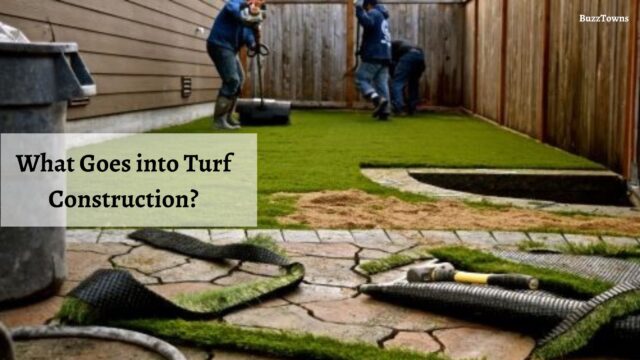When it comes to outdoor spaces, few things are as versatile and effective as turf. A well-maintained artificial turf lawn can be the perfect place for relaxation, socializing, and general enjoyment of the outdoors—but only if it’s constructed correctly.
There are several different types of turf that can be installed as well as an array of different surface textures and designs to choose from, depending on how you want your artificial turf to look, feel, and function.
Here’s everything you need to know about turf construction for your home or business.
What Is Artificial Turf?
Artificial turf, also known as synthetic turf or fake grass, is made of manmade fibers such as nylon, polypropylene, or polyethylene. These materials are woven together to create a surface that looks and feels like real grass. It can be installed in a variety of settings, including commercial properties, schools, residential properties, and indoor spaces.
Turf is an excellent choice for homeowners because it requires very little maintenance. It’s green all year long, requires no watering, and requires no mowing. You can also install turf in places where it would be impractical, or perhaps even impossible, to grow a real lawn from seed.
Its ease of maintenance means it can withstand a variety of challenging conditions including extreme weather and heavy use. For example, it is often used in play areas for children since it is safer than natural grass and can be installed over a variety of surfaces.
Different Kinds of Artificial Turf
Before going into the turf construction process, you need to familiarize yourself with the various types of artificial turf on the market. They include:
Synthetic Turf
Synthetic turf is made from a variety of materials that replicate the look, texture, and feel of natural grass. It is most commonly made from recycled synthetic materials but also can include natural fibers.
Synthetic grass is most commonly used in commercial applications; however, there are synthetic options that are made to withstand residential use.
Knitted Turf
Knitted turf is similar to synthetic turf, but has an aesthetic design woven into the material. This can create a more subtle design that is great for residential properties.
Natural Fiber Turf
Natural fiber turf is made from real grass fibers but is not suitable for residential use since it does not withstand as much wear and tear, especially in high-traffic areas.
Artificial Turf Installation Process
Choose the Right Turf
The first step when it comes to turf construction is choosing the right material for the job. While there are many varieties of artificial turf on the market, not all of them are suitable for your needs. Some are ideal for sports fields while others are best for lawn use. Discuss the options with your installer to determine which is best for your uses.
You’ll want to assess the soil on your property where you want to install the artificial turf during this phase. The soil you have will determine the quality of the turf and how easy it is to maintain.
While a variety of soil types work for installing turf, you’ll find that silt and clay soils are slightly more challenging to install because they can be more prone to erosion. Sandy soils, however, are the easiest to install because they are relatively level (particularly if they are used to cover an existing piece of land). They also tend to be less compacted and have low organic matter, making them ideal for artificial turf. They also drain water quickly, making them an excellent option for areas that are prone to flooding.
The soil on your property needs to be able to drain well so that water doesn’t pool on the surface and cause it to become waterlogged. Silt and clay simply don’t drain as well, but you can install drainage tiles to correct the issue.
Prepare the Space
The next step in the installation process of artificial turf is to measure and mark the areas where the turf will be installed. This will ensure that the turf is laid out in a way that best suits the space.
Once this is done, proceed to excavate the surface. You also want to make sure that the topography of your soil is even. This ensures that water will be able to run off the surface in a way that doesn’t cause erosion. The depth of the excavation will depend on the type of soil that the turf will be laid over. The soil will then be compacted and graded to ensure that it is level.
Construct the Turf
After the soil is prepared, the installer will lay down the layers needed for artificial turf construction.
- Drainage layer. This is a layer of rock to ensure water drains from the turf above and doesn’t pool.
- Base layer. This is the solid, compacted layer that supports the artificial turf.
- Infill layer. Infill helps to give the artificial grass a more natural appearance. It’s generally made of recycled rubber or cork. It also makes it a more pliable surface for regular activity.
- Turf layer. Finally, the artificial turf is laid out on top of the infill and attached to the ground using staples or steel nails. The turf is then trimmed to size to fit your space.
From high school football fields to residential lawns, turf installations are on the rise. It looks great, it’s low maintenance, pet owners love it because it’s easy to clean up, and it’s green year-round. So, if you’re looking to bring some much-needed green space to your home or business, artificial turf may be just the solution you’re looking for.
For installation, be sure to hire a contractor that specializes in turf construction, such as Sportech Construction in Oregon, and can do the work from excavation to lush green lawn. When you work with an expert, you can expect nothing but the most professional service and artificial turf construction that will look great for years to come.









